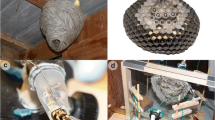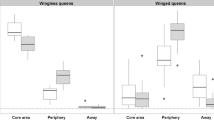Summary
Technomyrmex albipes makes huge polydomous colonies which consist of up to several millions of adults. In field colonies, dealate queens are rare or absent, though winged males and winged females emerge annually (synchronously) in large numbers from late may to mid June. Field and laboratory observations showed that the reproduction of established colonies was performed by wingless females inseminated by wingless males from the same colony. Dissections and morphological examinations revealed that wingless females are workers with no spermatheca and intercastes with a spermatheca. Most intercastes were inseminated, had developed ovaries, and seemed to reproduce, while workers did not seem to reproduce. Extranidal tasks were performed only by workers. Approximately half of the adult population were intercastes, and wingless males represented only a small portion of all adults, the rest being nonreproductive workers. Intercastes and wingless males were produced throughout the year except in winter. The winged females and males copulate outside the nest only after the nuptial flight and the dealate females are able to perform independent founding, but they are also eventually supplanted by intercastes. The adoption of dealate queens by an established natal colony did not seem to occur. Thus we infer that in this species the winged reproductives disperse and found new colonies, while inbred wingless reproductives allow the enlargement and budding of colonies. This species has a special trophic-flow system. There is no trophallaxis among adults, and nutrient transfer from adults to other colony members is achieved exclusively by specialized trophic eggs. All females (dealate queens, intercastes, and workers) seem to produce trophic eggs. This aphid-like life cycle, i.e., the occurrence of both winged and wingless reproductive forms, may have evolved as an adaptation supporting the development of secondary polygyny and polydomy.
Similar content being viewed by others
References
Bartz SH, Hölldobler B (1982) Colony founding in Myrmecocystus mimicus Wheeler (Hymenoptera, Formicidae) and the evolution of foundress associations. Behav Ecol Sociobiol 10:137–147
Bolton B (1986) Apterous females and shift of dispersal strategy in the Monomoriun salomonis group (Hymenoptera: Formicidae). J Nat Hist 20:267–272
Buschinger A (1974) Monogynie und Polygynie in Insektensozietäten. In: Schmidt GH (ed) Sozialpolymorphismus bei Insekten. Wissenschaftliche Verlagsgesellschaft, Stuttgart, pp 862–895
Buschinger A (1978) Genetisch bedingte Entstehung geflügelter Weibchen bei der sklavenhaltenden Ameise Harpagoxenus sublaevis (Nyl) (Hym., Form.). Insectes Soc 25:163–177
Buschinger A (1987) Polymorphism and reproductive division of labor in advanced ants. In: Eder J, Rembold H (eds) Chemistry and biology of social insects. Peperny, Munich, pp 257–258
Craig R, Crozier RH (1979) Relatedness in the polygynous ant Myrmecia pilosula. Evolution 33:335–341
Hamilton WD (1972) Altruism and related phenomena, mainly in social insects. Annu Rev Ecol Syst 3:193–232
Heinze J, Buschinger A (1989) Queen polymorphism in Leptothorax spec. A: its genetic and ecological background (Hymenoptera: Formicidae). Insectes Soc 36:139–155
Hölldobler B, Carlin NF (1989) Colony founding, queen control and worker reproduction in the ant Aphaenogaster (= Novomessor) cockerlli (Hymenoptera: Formicidae). Psyche 96:131–151
Hölldobler B, Wilson EO (1977) The number of queens: an important trait in ant evolution. Naturwissenschaften 64:8–15
Holldobler B, Wilson EO (1990) The Ants. Harvard University Press, Cambridge MA
Keller L, Passera L (1988) Size and fat content of gynes in relation to the mode of colony founding in ants (Hymenoptera; Formicidae). Oecologia 80:236–240
Keller L, Passera L (1990) Queen number, social structure, reproductive strategies and their correlations in ants. In: Veeresh GK, Mallik B, Viraktamath CA (eds) Social insects and the environment. Oxford and IBH, New Delhi, pp 236–237
Kinomura K, Yamauchi K (1987) Fighting and mating behaviors of dimorphic males in the ant Cardiocondyla wroughtoni. J Ethol 5:75–81
Nonacs P (1986) Ant reproductive strategies and sex allocation theory. Q Rev Biol 61:1–21
Nonacs P (1988) Queen number in colonies of social Hymenoptera as a kin selected adaptation. Evolution 42:566–580
Pamilo P (1981) Genetic organization of Formica sanguinea populations. Behav Ecol Sociobiol 9:45–50
Pamilo P (1982) Genetic population structure in polygynous Formica ants. Heredity 48:95–106
Pamilo P, Varvio-Aho S-L (1979) Genetic structure of nests in the ant Formica sanguinea. Behav Ecol Sociobiol 6:91–98
Peeters C (1991) Ergatoid queens and intercastes in ants: two distinct adult forms which look morphologically intermediate between workers and winged queens. Insectes Soc 38:1–15
Peeters C, Crozier RH (1988) Caste and reproduction in ants: not all mated egg-layers are “queens”. Psyche 95:283–288
Rissing SW, Pollock GB (1988) Pleometrosis and polygyny in ants. In: Jeanne RL (ed) Interindividual behavioral variability in social insects. Westview, Boulder, pp 179–222
Rosengren R, Pamilo P (1985) The evolution of polygyny and polydomy in mound-building Formica ants. Acta Entomologica Fennica 42:65–77
Ross KG, Fletcher DJC (1985) Comparative study of genetic and social structure in two forms of the fire ant Solenopsis invicta (Hymenoptera, Formicidae). Behav Ecol Sociobiol 17:349–356
Stille M, Stille Bo, Douwes P (1991) Polygyny, relatedness and nest founding in the polygynous myrmicine ant Leptothorax acervorm (Hymenoptera; Formicidae). Behav Ecol Sociobiol 28:91–96
Stuart R (1987) Lethal Fighting among dimorphic males of the ant, Cardiocondyla wroughtoni. Naturwissenschaften 74:548–549
Terron G (1972a) La ponte des ouvrières fećondées chez une fourmi camerounaise du genre Technomyrmex Mayr: mise en évidence d'une descendance ouvriére. CR Acad Sci Paris ser D 274:1516–1517
Terron G (1972b) Observations sur les mâles ergatoïdes et les males ailés chez une fourmi du genre Technomyrmex Mayr (Hym., Formicidae, Dolichoderinae). Ann Fac Sci Cameroun 10:107–120
Torossian Cl (1959) Les échanges trophallactiques proctotdéaux chez la fourmi Dolichoderus quadripunctatus (Hyménoptère-Formicoidea). Insectes Soc 6:369–374
Torossian Cl (1961) Les échanges trophallactiques proctodéaux chez 1a fourmi d'Argentine: Iridomyrmex humilis (Hym. Form. Dolichoderidae). Insectes Soc 8:189–191
Tsuji K, Furukawa T, Kinomura K, Takamine H, Yamauchi K (1992) The caste system of the dolichoderine ant Technomyrmex albipes: morphological description of queens, workers and reproductively active intercastes. Insectes Soc (in press)
Ward PS (1983) Genetic relatedness and colony organization in a species complex of ponerine ants. I. Phenotypic and genotypic composition of colonies. Behav Ecol Sociobiol 12:285–299
Wilson EO (1963) The social biology of ants. Annu Rev Entomol 8:345–368
Winter U, Buschinger A (1986) Genetically mediated queen polymorphism and caste determination in the slave-making ant Harpagoxenus sublaevis (Hymenoptera: Formicidae). Entomol Gen 11:125–137
Yamauchi K, Kinomura K, Miyake S (1981) Sociobiological studies of the polygynic ant Lasius sakagamii. I. General features of its polydomous system. Insectes Soc 28:279–296
Yamauchi K, Kinomura K, Miyake S (1982) Sociobiological studies of the polygynic ant Lasius sakagamii. II. Production of colony members. Insectes Soc 29:164–174
Author information
Authors and Affiliations
Additional information
Offprint requests to: K. Yamauchi
Rights and permissions
About this article
Cite this article
Yamauchi, K., Furukawa, T., Kinomura, K. et al. Secondary polygyny by inbred wingless sexuals in the dolichoderine ant Technomyrmex albipes . Behav Ecol Sociobiol 29, 313–319 (1991). https://doi.org/10.1007/BF00165955
Received:
Accepted:
Issue Date:
DOI: https://doi.org/10.1007/BF00165955




